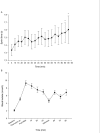Fatigue Responses in Various Muscle Groups in Well-Trained Competitive Male Players after a Simulated Soccer Game
- PMID: 29599862
- PMCID: PMC5873339
- DOI: 10.1515/hukin-2017-0129
Fatigue Responses in Various Muscle Groups in Well-Trained Competitive Male Players after a Simulated Soccer Game
Abstract
We examined the degree of post-game fatigue and the recovery pattern in various leg and upper-body muscle groups after a simulated soccer game. Well-trained competitive male soccer players (n = 12) participated in the study. The players completed the Copenhagen Soccer Test, a 2 x 45 min simulated soccer protocol, following baseline measures of maximal voluntary contractions of multiple muscle groups and systemic markers of muscle damage and inflammation at 0, 24 and 48 h into recovery. All muscle groups had a strength decrement (p ≤ 0.05) at 0 h post-match with knee flexors (14 ± 3%) and hip abductors (6 ± 1%) demonstrating the largest and smallest impairment. However, 24 h into recovery all individual muscles had recovered. When pooled in specific muscle groups, the trunk muscles and knee joint muscles presented the largest decline 0 h post-match, 11 ± 2% for both, with the performance decrement still persistent (4 ± 1%, p ≤ 0.05) for trunk muscles 24 h into recovery. Large inter-player variations were observed in game-induced fatigue and recovery patterns in the various muscle groups. Markers of muscle damage and inflammation peaked 0 h post-match (myoglobin) and 24 h into recovery (creatine kinase), respectively, but thereafter returned to baseline. Intermittent test performance correlated with creatine kinase activity 24 h after the Copenhagen Soccer Test (r = -0.70; p = 0.02). In conclusion, post-game fatigue is evident in multiple muscle groups with knee flexors showing the greatest performance decrement. Fatigue and recovery patterns vary markedly between muscle groups and players, yet trunk muscles display the slowest recovery.
Keywords: inflammation; muscle damage; muscle fatigue; recovery; soccer.
Figures



References
-
- Andersson H, Raastad T, Nilsson J, Paulsen G, Garthe I, Kadi F. Neuromuscular fatigue and recovery in elite female soccer: effects of active recovery. Med Sci Sports Exerc. 2008;40:372–380. - PubMed
-
- Ascensao A, Leite M, Rebelo AN, Magalhäes S, Magalhäes J. Effects of cold water immersion on the recovery of physical performance and muscle damage following a one-off soccer match. J Sports Sci. 2011;29:217–225. - PubMed
-
- Ascensão A, Rebelo A, Oliveira E, Marques F, Pereira L, Magalhães J. Biochemical impact of a soccer match - analysis of oxidative stress and muscle damage markers throughout recovery. Clin Biochem. 2008;41:841–851. - PubMed
-
- Bangsbo J, Marcello laia F, Krustrup P. Metabolic Response and Fatigue in Soccer. International J Sports Physiol Perform. 2007;2:111–127. - PubMed
-
- Behm DG, Cappa D, Power GA. Trunk muscle activation during moderate-and high-intensity running. Appl Physiol Nutr Metab. 2009;34:1008–1016. - PubMed
LinkOut - more resources
Full Text Sources
Other Literature Sources
